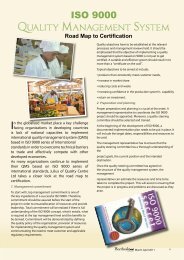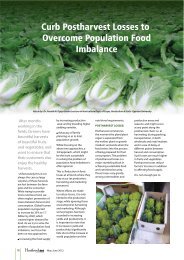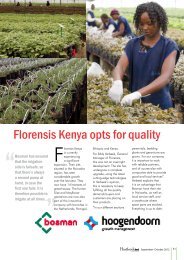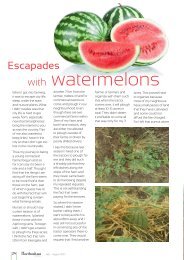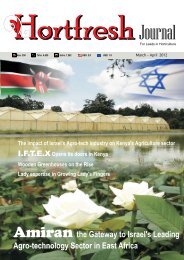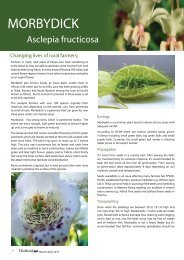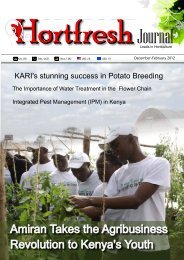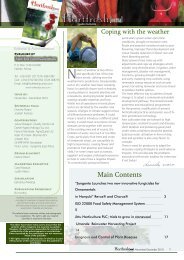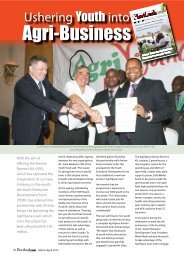Hortifresh Nov__December 2012.indd - Hortfresh Journal
Hortifresh Nov__December 2012.indd - Hortfresh Journal
Hortifresh Nov__December 2012.indd - Hortfresh Journal
- No tags were found...
You also want an ePaper? Increase the reach of your titles
YUMPU automatically turns print PDFs into web optimized ePapers that Google loves.
(LDPE), linear low-densitypolyethylene (LLDPE), highdensitypolyethylene (HDPE),polypropylene (PP), polyvinylchloride (PVC), polyester, i.e.polyethylene terephthalate(PET), polyvinylidene chloride(PVDC), polyamide (Nylon)and other suitable films.Many factors influencefilm permeability, amongwhich polymer type and filmthickness are most important.Due to differences in therespiration rates of individualfruits or vegetables, the typeof plastic film required toachieve any special equilibriumMA must be defined for eachcommodity. The transmissionof CO 2 and O 2 throughplastic films will vary withfilm types, but generallyfilms are 4 to 6 times morepermeable to CO 2 than to O 2 .Perforations - Punchingholes in the plastic canmaintain high humidity aroundthe produce, but it may beless effective in delaying fruitripening because it does nothave the same effect onthe CO 2 and O 2 contents ofthe atmospheres inside thebag. The holes may be verysmall and in these casesthey are commonly referredto as micro-perforations.Figure 2Current applicationsof MAP technology forfresh and minimallyprocessed productsWith commodity-generatedor passive MA, if productand film permeabilitycharacteristics are properlymatched, the desiredMA can passively evolvewithin a sealed packagethrough consumption ofO 2 and production of CO 2by respiration. The gaspermeability of the selectedfilm must allow O 2 to enterthe package at a rate offsetby the consumption of O 2by the commodity. Similarly,CO 2 must be vented fromthe package to offset theproduction of CO 2 by thecommodity. Furthermore,the desired MA must beestablished within 1 to 2dayswithout creating anoxicconditions or injuriously highlevels of CO 2 that may inducefermentative metabolism.Recent advances in thetechnology of manufacturingpolymeric films havepermitted tailoring films forspecific gas diffusion needsof some fruit, vegetables, andtheir products. MAP is mostcommonly used for freshcut (minimally process ed)fruit and vegetables andfor highly perishable, highvalue commodities, suchas strawberry (Fragariaananassa Duch.).Benefits of film packaging,other than creation ofMA conditions can includemaintenance of high relativehumidity and reductionof water loss; improvedsanitation by reducingcontamination of theproducts during handling;minimized surface abrasionsby avoiding contact betweenthe commodity and thematerial of the shippingcontainer; reduced spreadof decay from one produceitem to another; facilitationof brand identification andproviding relevant informationto the consumers. In manycases the benefits of usingMAP relate more to one ormore of these positive effectsthan to the changes in O 2 andCO 2 concentrations withinthe package. In contrast,the negative effects includeslowing down cooling ofthe packaged productsand increased potential forwater condensation withinthe package, which mayencourage fungal growth.Figure 3CONCLUSION:The rapid growth of MAPproducts in the marketplaceindicates that the benefitsof the system to theretailer, manufacturer, andconsumer clearly outweighthe disadvantages.Food safety must continue tobe of prime concern of MAPfood. The effective and safeuse of MAP requires effectivecontrol of temperature.Poor temperature controleliminates the beneficialeffects of any MAP systemand may cause health hazards.Figure 2 Micro-perforated ModifiedAtmosphere PackageFigure 3. Water condensation in MAP<strong>Nov</strong>ember - <strong>December</strong> 2012For leads in Horticulture21



